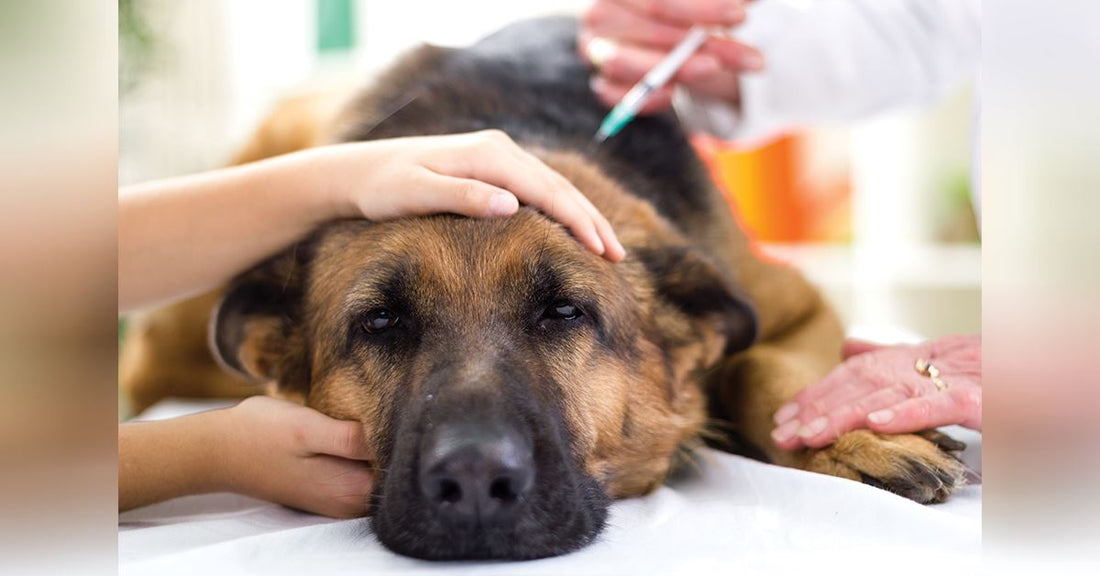Cancer Warning Signs In German Shepherds

These six little letters – CANCER – have the power to strike fear into all dog lovers. And, with approximately one in four dogs developing cancer in their lifetime, the danger is real. The good news is, with early diagnosis and treatment, today’s pets have a better chance of being successfully treated for cancer than ever before.
What is Cancer in Dogs?
Cancer is the result of abnormal malignant cells or tissue growth invading the body. However, not all growths, otherwise known as neoplasms, are cancerous. According to the AAHA, with treatment, about half of canine cancers are treatable when caught early enough.

According to the American Veterinary Medical Association:
“Neoplasia is the uncontrolled, abnormal growth of cells or tissues in the body, and the abnormal growth itself is called a neoplasm or tumor. It can be benign or malignant. Benign neoplasms tend to grow slowly; displace, but do not tend to invade, the surrounding body tissues; and do not spread throughout the body. Malignant neoplasms, on the other hand, can be unpredictable and grow at various rates (sometimes rapidly), invade the tissues around them, and spread, or metastasize, to other parts of the body. The word “tumor” or “mass” is often used to describe the actual swelling or other physical appearance of a neoplasm. The word “cancer” is often confused with neoplasia, but only malignant neoplasms are truly cancers.”
About one in four dogs will develop a neoplasia in their lifetime. And, almost half of dogs over age ten will develop cancer. Shockingly, this is about the same rate that humans get cancer. So, it is just as important to take care of your own health as your dogs.

Possible Signs of Cancer in Dogs
Not all lumps, bumps, sores, pain, etc., are caused by cancer. However, the incidence of cancer in dogs is high enough that warning signs shouldn’t be ignored. While it’s not possible to detect all cancer just by observing your dog, these physical signs can be a signal that your dog has neoplasia or cancer:
• Hard or soft bumps, lumps, and skin discolorations
• Visible masses or tumors on or under the skin
• Areas of swelling
• Pain and lameness with no explanation
• Sores that do not heal
• Bleeding from the nose, mouth, rectum
• Discharge from body openings
• Diarrhea or vomiting that is not responding to treatment
• Breathing difficulty
• Eating difficulty
• Lack of appetite
• Lethargy, weakness
• Swollen lymph nodes
• Difficulty urinating or defecating
If your German shepherd has any of these warning signs, they need to see a vet as soon as possible. Although there are many issues that can cause these symptoms, a veterinarian needs to determine the root cause to rule out a malignancy right away. Plus, neoplasia is highly treatable, and an early diagnosis will ensure your dog receives the quickest intervention possible.

Common Cancers in Dogs
Dogs can suffer from many types of cancer. Some of the most common include:
• Lymphoma (accounts for 20% of canine cancers)
• Mast cell tumors (often starts on the skin)
• Osteosarcoma (rapidly growing bone cancer)
• Melanoma (difficult to treat cancer that usually begins in the oral cavity but spreads)
• Mammary gland carcinoma (begins as a nodule near the nipple)
• Lung cancer (tumor in the lung)
• Hemangiosarcoma (attacks the spleen, liver, heart and skin-common in German Shepherds)

How Canine Cancer is Diagnosed
It’s important to physically examine your dog every month, especially as they age by running your hands over their entire body and paying attention to their lymph nodes, nose, mouth, and skin. Being familiar with what is normal for your dog will help you recognize small changes, before they turn into something serious.
If you find something unusual, contact your vet who will then examine your dog to determine if further tests are necessary. If required, x-rays, blood tests, and ultrasounds are usually performed confirm a neoplasia.
If your dog has a mass or tumor, a cytology (needle aspiration to withdraw some cells from a mass to examine under a microscope) will be performed. This will provide basic information about the tumor type, rule out cancer, or confirm a diagnosis for certain types of cancer.
Further, a biopsy (a tissue sample examined under a microscope) may also necessary to confirm if the neoplasm is benign or malignant. Additional samples of other tissues, such as lymph nodes, may be necessary to determine if there is cancer present and if so, how far it has spread.
If your dog does have cancer, your vet will probably refer you to an oncology specialist. Depending on the type of cancer and treatment options available, further diagnostics, such as a CT scan or MRI may be necessary.
Once you have diagnosis, your cancer treatment options may include:
• Surgery
• Chemotherapy
• Immunotherapy
• Cryotherapy
• Hypothermia
• Radiation
• Nutrition
As with any cancer, the earlier canine cancer is detected, the better the prognosis and treatment options. Quick intervention can help to improve recovery rates and provide the best quality of life for your dog.
As always, we hope you found this information helpful and wish you and your dog well. Please feel free to share with your friends.
You might also like: 13 Ways to Keep Your German Shepherd Healthy And Happy
























